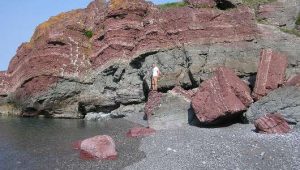
An international team including scientists at the University of St Andrews has unlocked the secret of one of the great events of Earth’s evolution – the Cambrian explosion.
Around 520 million years ago, a wide variety of animals burst onto the evolutionary scene in an event known as the Cambrian explosion. In perhaps as few as 10 million years, marine animals evolved most of the basic body forms that we observe in modern groups.
The event has sparked fierce debate all the way back to Darwin. Some paleontologists see the Cambrian explosion as a real, astonishing episode of unprecedented, fast evolution. Others suggest it is a false artifact of an unreliable fossil record.
Now work published in the American Journal of Science shows that these competing theories can be unified by the geography of Cambrian Earth, as it underwent a wholesale lurch that clustered most of Earth’s continents around the equator.
Co-author Dr Timothy Raub of the Department of Earth and Environmental Sciences at the University of St Andrews said: “In a nutshell both camps were right. The particular locations of Cambrian continents relative to each other was special in a way that supercharged animal speciation while preserving an unusually good record of those early fossils.”
The key event, proposed long ago by co-author Joseph Kirschvink from Caltech and Japan’s Earth-Life Science Institute (ELSI), was a massive episode of what is known as ‘true polar wander’. Raub, Kirschvink, and lead author Ross Mitchell of Caltech and Yale University are among scientists who have bolstered the evidence for true polar wander and developed predictions of its consequences in recent years.
Earth’s continental and oceanic plates are in constant motion relative to one another, but in rare episodes of true polar wander, the entire solid Earth slips about its liquid outer core over the course of five to ten millions years, causing the geographic locations of Earth’s plates to shift altogether in the same sense.
The paper suggests that about 520 million years ago a lurch of more than 60 degrees moved most continents from polar to tropical latitudes. For reasons that are still debated, biological diversity reaches a global peak around the equator and tapers off closer to the poles. This early Cambrian rotation therefore would have dramatically increased shallow coastal area in Earth’s biodiversity hotspot.
As another consequence of true polar wander, continents moving towards the equator are flooded by hundreds of metres of sea level rise, as they encounter the great bulge of water caused by Earth’s daily spin. This flooding would have increased fossil preservation, but it also would have opened up new habitats for rapid diversification, in particular vast continental seaways rife with previously unexplored ecological niches.
Cambrian true polar wander happened at a time when Earth was already seeded with many of the traits that subsequently radiated throughout the Tree of Life.
Dr Raub (pictured) said: “A bunch of wonderful ideas have been published emphasising one or another aspect of the Cambrian biosphere as the crucial link in the explosion of animal life. An appealing aspect of our study is that a geographic contingency – the shape and arrangement of the Cambrian continents and the direction of the remarkable true polar wander shift – can support almost all those ideas simultaneously. At the same time, it turns out that preservation of Cambrian fossils really was enhanced over that of other ages.
“This new geographic framework answers a debate going back over a hundred years. It should encourage scientists to review all sorts of old and new hypotheses, which no longer must fit into the evolution or preservation camp exclusively.”
Reference:
‘Was the Cambrian explosion both an effect and an artifact of true polar wander?’ Ross N. Mitchell, Timothy D. Raub, Samuel C. Silva, Joseph L. Kirschvink is published in the American Journal of Science. DOI: 10.2475/10.2015.02
Note: The above post is reprinted from materials provided by University of St Andrews.










